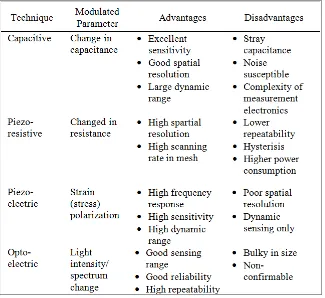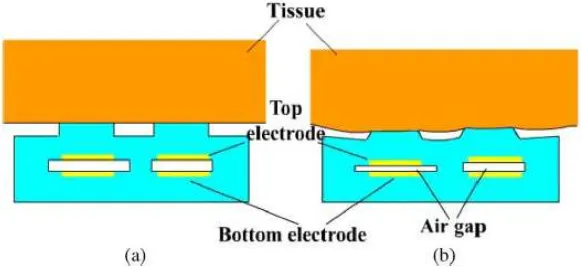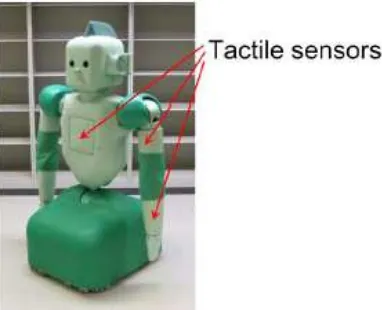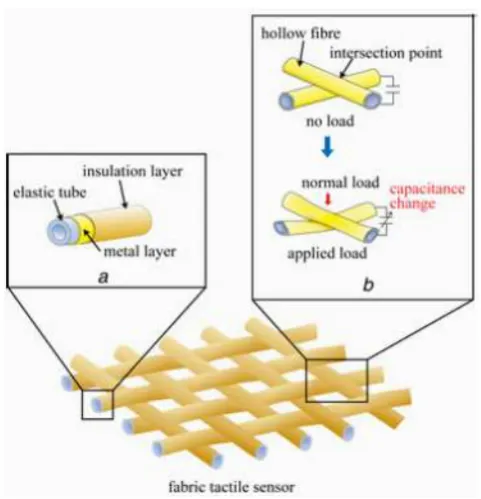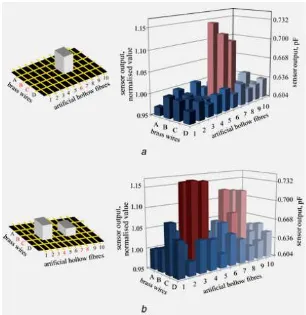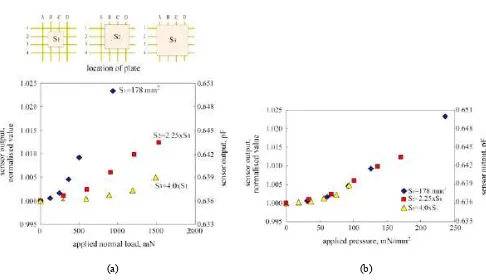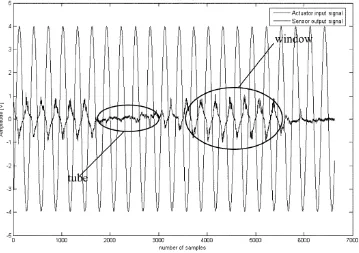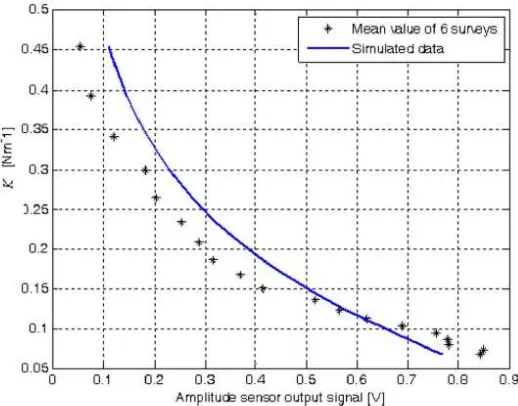S
Seennssoorrss && TTrraannssdduucceerrss
Volume 143, Issue 8 August 2012
www.sensorsportal.com ISSN 1726-5479
Editors-in-Chief: professor Sergey Y. Yurish, tel.: +34 696067716, e-mail: editor@sensorsportal.com Editors for Western Europe
Meijer, Gerard C.M., Delft University of Technology, The Netherlands Ferrari, Vittorio, Universitá di Brescia, Italy
Editors for North America
Datskos, Panos G., Oak Ridge National Laboratory, USA Fabien, J. Josse, Marquette University, USA
Katz, Evgeny, Clarkson University, USA
Editor South America
Costa-Felix, Rodrigo, Inmetro, Brazil
Editor for Eastern Europe
Sachenko, Anatoly, Ternopil State Economic University, Ukraine
Editor for Asia
Ohyama, Shinji, Tokyo Institute of Technology, Japan
Editor for Africa
Maki K.Habib, American University in Cairo, Egypt
Editor for Asia-Pacific
Mukhopadhyay, Subhas, Massey University, New Zealand
Editorial Advisory Board
Abdul Rahim, Ruzairi, Universiti Teknologi, Malaysia
Ahmad, Mohd Noor, Nothern University of Engineering, Malaysia Annamalai, Karthigeyan, National Institute of Advanced Industrial Science
and Technology, Japan
Arcega, Francisco, University of Zaragoza, Spain Arguel, Philippe, CNRS, France
Ahn, Jae-Pyoung, Korea Institute of Science and Technology, Korea Arndt, Michael, Robert Bosch GmbH, Germany
Ascoli, Giorgio, George Mason University, USA Atalay, Selcuk, Inonu University, Turkey Atghiaee, Ahmad, University of Tehran, Iran
Augutis, Vygantas, Kaunas University of Technology, Lithuania Avachit, Patil Lalchand, North Maharashtra University, India Ayesh, Aladdin, De Montfort University, UK
Azamimi, Azian binti Abdullah, Universiti Malaysia Perlis, Malaysia Bahreyni, Behraad, University of Manitoba, Canada
Baliga, Shankar, B., General Monitors Transnational, USA Baoxian, Ye, Zhengzhou University, China
Barford, Lee, Agilent Laboratories, USA Barlingay, Ravindra, RF Arrays Systems, India Basu, Sukumar, Jadavpur University, India Beck, Stephen, University of Sheffield, UK
Ben Bouzid, Sihem, Institut National de Recherche Scientifique, Tunisia Benachaiba, Chellali, Universitaire de Bechar, Algeria
Binnie, T. David, Napier University, UK
Bischoff, Gerlinde, Inst. Analytical Chemistry, Germany Bodas, Dhananjay, IMTEK, Germany
Borges Carval, Nuno, Universidade de Aveiro, Portugal Bouchikhi, Benachir, University Moulay Ismail, Morocco Bousbia-Salah, Mounir, University of Annaba, Algeria Bouvet, Marcel, CNRS – UPMC, France
Brudzewski, Kazimierz, Warsaw University of Technology, Poland Cai, Chenxin, Nanjing Normal University, China
Cai, Qingyun, Hunan University, China
Calvo-Gallego, Jaime, Universidad de Salamanca, Spain Campanella, Luigi, University La Sapienza, Italy Carvalho, Vitor, Minho University, Portugal Cecelja, Franjo, Brunel University, London, UK Cerda Belmonte, Judith, Imperial College London, UK
Chakrabarty, Chandan Kumar, Universiti Tenaga Nasional, Malaysia Chakravorty, Dipankar, Association for the Cultivation of Science, India Changhai, Ru, Harbin Engineering University, China
Chaudhari, Gajanan, Shri Shivaji Science College, India
Chavali, Murthy, N.I. Center for Higher Education, (N.I. University), India Chen, Jiming, Zhejiang University, China
Chen, Rongshun, National Tsing Hua University, Taiwan Cheng, Kuo-Sheng, National Cheng Kung University, Taiwan
Chiang, Jeffrey (Cheng-Ta), Industrial Technol. Research Institute, Taiwan Chiriac, Horia, National Institute of Research and Development, Romania Chowdhuri, Arijit, University of Delhi, India
Chung, Wen-Yaw, Chung Yuan Christian University, Taiwan Corres, Jesus, Universidad Publica de Navarra, Spain
Cortes, Camilo A., Universidad Nacional de Colombia, Colombia Courtois, Christian, Universite de Valenciennes, France Cusano, Andrea, University of Sannio, Italy
D'Amico, Arnaldo, Università di Tor Vergata, Italy
De Stefano, Luca, Institute for Microelectronics and Microsystem, Italy Deshmukh, Kiran, Shri Shivaji Mahavidyalaya, Barshi, India Dickert, Franz L., Vienna University, Austria
Dieguez, Angel, University of Barcelona, Spain
Dighavkar, C. G., M.G. Vidyamandir’s L. V.H. College, India Dimitropoulos, Panos, University of Thessaly, Greece Ding, Jianning, Jiangsu Polytechnic University, China
Djordjevich, Alexandar, City University of Hong Kong, Hong Kong Donato, Nicola, University of Messina, Italy
Donato, Patricio, Universidad de Mar del Plata, Argentina Dong, Feng, Tianjin University, China
Drljaca, Predrag, Instersema Sensoric SA, Switzerland Dubey, Venketesh, Bournemouth University, UK
Enderle, Stefan, Univ.of Ulm and KTB Mechatronics GmbH, Germany Erdem, Gursan K. Arzum, Ege University, Turkey
Erkmen, Aydan M., Middle East Technical University, Turkey Estelle, Patrice, Insa Rennes, France
Estrada, Horacio, University of North Carolina, USA Faiz, Adil, INSA Lyon, France
Fericean, Sorin, Balluff GmbH, Germany Fernandes, Joana M., University of Porto, Portugal
Francioso, Luca, CNR-IMM Institute for Microelectronics and Microsystems, Italy Francis, Laurent, University Catholique de Louvain, Belgium
Fu, Weiling, South-Western Hospital, Chongqing, China Gaura, Elena, Coventry University, UK
Geng, Yanfeng, China University of Petroleum, China Gole, James, Georgia Institute of Technology, USA Gong, Hao, National University of Singapore, Singapore Gonzalez de la Rosa, Juan Jose, University of Cadiz, Spain Granel, Annette, Goteborg University, Sweden
Graff, Mason, The University of Texas at Arlington, USA Guan, Shan, Eastman Kodak, USA
Guillet, Bruno, University of Caen, France Guo, Zhen, New Jersey Institute of Technology, USA Gupta, Narendra Kumar, Napier University, UK Hadjiloucas, Sillas, The University of Reading, UK Haider, Mohammad R., Sonoma State University, USA Hashsham, Syed, Michigan State University, USA Hasni, Abdelhafid, Bechar University, Algeria Hernandez, Alvaro, University of Alcala, Spain
Hernandez, Wilmar, Universidad Politecnica de Madrid, Spain Homentcovschi, Dorel, SUNY Binghamton, USA
Horstman, Tom, U.S. Automation Group, LLC, USA Hsiai, Tzung (John), University of Southern California, USA Huang, Jeng-Sheng, Chung Yuan Christian University, Taiwan Huang, Star, National Tsing Hua University, Taiwan Huang, Wei, PSG Design Center, USA
Hui, David, University of New Orleans, USA
Jaffrezic-Renault, Nicole, Ecole Centrale de Lyon, France James, Daniel, Griffith University, Australia
Janting, Jakob, DELTA Danish Electronics, Denmark Jiang, Liudi, University of Southampton, UK Jiang, Wei, University of Virginia, USA Jiao, Zheng, Shanghai University, China John, Joachim, IMEC, Belgium
Kalach, Andrew, Voronezh Institute of Ministry of Interior, Russia Kang, Moonho, Sunmoon University, Korea South
Kaniusas, Eugenijus, Vienna University of Technology, Austria Katake, Anup, Texas A&M University, USA
Kausel, Wilfried, University of Music, Vienna, Austria Kavasoglu, Nese, Mugla University, Turkey Ke, Cathy, Tyndall National Institute, Ireland Khelfaoui, Rachid, Université de Bechar, Algeria Khan, Asif, Aligarh Muslim University, Aligarh, India Kim, Min Young, Kyungpook National University, Korea South Ko, Sang Choon, Electronics. and Telecom. Research Inst., Korea South Kotulska, Malgorzata, Wroclaw University of Technology, Poland Kockar, Hakan, Balikesir University, Turkey
Krishnamoorthy, Ganesh, University of Texas at Austin, USA Kumar, Arun, University of Delaware, Newark, USA Kumar, Subodh, National Physical Laboratory, India Kung, Chih-Hsien, Chang-Jung Christian University, Taiwan Lacnjevac, Caslav, University of Belgrade, Serbia
Lay-Ekuakille, Aime, University of Lecce, Italy Lee, Jang Myung, Pusan National University, Korea South Lee, Jun Su, Amkor Technology, Inc. South Korea Lei, Hua, National Starch and Chemical Company, USA Li, Fengyuan (Thomas), Purdue University, USA Li, Genxi, Nanjing University, China
Li, Hui, Shanghai Jiaotong University, China Li, Sihua, Agiltron, Inc., USA
Li, Xian-Fang, Central South University, China Li, Yuefa, Wayne State University, USA
Liang, Yuanchang, University of Washington, USA Liawruangrath, Saisunee, Chiang Mai University, Thailand Liew, Kim Meow, City University of Hong Kong, Hong Kong Lin, Hermann, National Kaohsiung University, Taiwan Lin, Paul, Cleveland State University, USA
Linderholm, Pontus, EPFL - Microsystems Laboratory, Switzerland Liu, Aihua, University of Oklahoma, USA
Liu Changgeng, Louisiana State University, USA Liu, Cheng-Hsien, National Tsing Hua University, Taiwan Liu, Songqin, Southeast University, China
Lodeiro, Carlos, University of Vigo, Spain
Lorenzo, Maria Encarnacio, Universidad Autonoma de Madrid, Spain Lukaszewicz, Jerzy Pawel, Nicholas Copernicus University, Poland Ma, Zhanfang, Northeast Normal University, China
Majstorovic, Vidosav, University of Belgrade, Serbia
Malyshev, V.V., National Research Centre ‘Kurchatov Institute’, Russia Marquez, Alfredo, Centro de Investigacion en Materiales Avanzados, Mexico Matay, Ladislav, Slovak Academy of Sciences, Slovakia
Mathur, Prafull, National Physical Laboratory, India
Maurya, D.K., Institute of Materials Research and Engineering, Singapore Mekid, Samir, University of Manchester, UK
Melnyk, Ivan, Photon Control Inc., Canada Mendes, Paulo, University of Minho, Portugal Mennell, Julie, Northumbria University, UK Mi, Bin, Boston Scientific Corporation, USA Minas, Graca, University of Minho, Portugal
Mishra, Vivekanand, National Institute of Technology, India Moghavvemi, Mahmoud, University of Malaya, Malaysia Mohammadi, Mohammad-Reza, University of Cambridge, UK Molina Flores, Esteban, Benemérita Universidad Autónoma de Puebla,
Mexico
Moradi, Majid, University of Kerman, Iran
Morello, Rosario, University "Mediterranea" of Reggio Calabria, Italy Mounir, Ben Ali, University of Sousse, Tunisia
Mrad, Nezih, Defence R&D, Canada
Mulla, Imtiaz Sirajuddin, National Chemical Laboratory, Pune, India Nabok, Aleksey, Sheffield Hallam University, UK
Neelamegam, Periasamy, Sastra Deemed University, India Neshkova, Milka, Bulgarian Academy of Sciences, Bulgaria Oberhammer, Joachim, Royal Institute of Technology, Sweden Ould Lahoucine, Cherif, University of Guelma, Algeria Pamidighanta, Sayanu, Bharat Electronics Limited (BEL), India Pan, Jisheng, Institute of Materials Research & Engineering, Singapore Park, Joon-Shik, Korea Electronics Technology Institute, Korea South Passaro, Vittorio M. N., Politecnico di Bari, Italy
Penza, Michele, ENEA C.R., Italy
Pereira, Jose Miguel, Instituto Politecnico de Setebal, Portugal Petsev, Dimiter, University of New Mexico, USA
Pogacnik, Lea, University of Ljubljana, Slovenia Post, Michael, National Research Council, Canada Prance, Robert, University of Sussex, UK Prasad, Ambika, Gulbarga University, India
Prateepasen, Asa, Kingmoungut's University of Technology, Thailand Pugno, Nicola M., Politecnico di Torino, Italy
Pullini, Daniele, Centro Ricerche FIAT, Italy
Pumera, Martin, National Institute for Materials Science, Japan Radhakrishnan, S. National Chemical Laboratory, Pune, India Rajanna, K., Indian Institute of Science, India
Ramadan, Qasem, Institute of Microelectronics, Singapore Rao, Basuthkar, Tata Inst. of Fundamental Research, India Raoof, Kosai, Joseph Fourier University of Grenoble, France Rastogi Shiva, K. University of Idaho, USA
Reig, Candid, University of Valencia, Spain Restivo, Maria Teresa, University of Porto, Portugal Robert, Michel, University Henri Poincare, France Rezazadeh, Ghader, Urmia University, Iran
Royo, Santiago, Universitat Politecnica de Catalunya, Spain Rodriguez, Angel, Universidad Politecnica de Cataluna, Spain Rothberg, Steve, Loughborough University, UK
Sadana, Ajit, University of Mississippi, USA
Sadeghian Marnani, Hamed, TU Delft, The Netherlands
Sapozhnikova, Ksenia, D.I.Mendeleyev Institute for Metrology, Russia
Sandacci, Serghei, Sensor Technology Ltd., UK
Saxena, Vibha, Bhbha Atomic Research Centre, Mumbai, India Schneider, John K., Ultra-Scan Corporation, USA
Sengupta, Deepak, Advance Bio-Photonics, India Seif, Selemani, Alabama A & M University, USA Seifter, Achim, Los Alamos National Laboratory, USA Shah, Kriyang, La Trobe University, Australia Sankarraj, Anand, Detector Electronics Corp., USA Silva Girao, Pedro, Technical University of Lisbon, Portugal Singh, V. R., National Physical Laboratory, India
Slomovitz, Daniel, UTE, Uruguay Smith, Martin, Open University, UK
Soleimanpour, Amir Masoud, University of Toledo, USA Soleymanpour, Ahmad, University of Toledo, USA
Somani, Prakash R., Centre for Materials for Electronics Technol., India Sridharan, M., Sastra University, India
Srinivas, Talabattula, Indian Institute of Science, Bangalore, India Srivastava, Arvind K., NanoSonix Inc., USA
Stefan-van Staden, Raluca-Ioana, University of Pretoria, South Africa Stefanescu, Dan Mihai, Romanian Measurement Society, Romania
Sumriddetchka, Sarun, National Electronics and Comp. Technol. Center, Thailand Sun, Chengliang, Polytechnic University, Hong-Kong
Sun, Dongming, Jilin University, China
Sun, Junhua, Beijing University of Aeronautics and Astronautics, China Sun, Zhiqiang, Central South University, China
Suri, C. Raman, Institute of Microbial Technology, India Sysoev, Victor, Saratov State Technical University, Russia
Szewczyk, Roman, Industr. Research Inst. for Automation and Measurement, Poland Tan, Ooi Kiang, Nanyang Technological University, Singapore,
Tang, Dianping, Southwest University, China
Tang, Jaw-Luen, National Chung Cheng University, Taiwan Teker, Kasif, Frostburg State University, USA
Thirunavukkarasu, I., Manipal University Karnataka, India Thumbavanam Pad, Kartik, Carnegie Mellon University, USA Tian, Gui Yun, University of Newcastle, UK
Tsiantos, Vassilios, Technological Educational Institute of Kaval, Greece Tsigara, Anna, National Hellenic Research Foundation, Greece Twomey, Karen, University College Cork, Ireland
Valente, Antonio, University, Vila Real, - U.T.A.D., Portugal Vanga, Raghav Rao, Summit Technology Services, Inc., USA Vaseashta, Ashok, Marshall University, USA
Vazquez, Carmen, Carlos III University in Madrid, Spain
Vieira, Manuela, Instituto Superior de Engenharia de Lisboa, Portugal Vigna, Benedetto, STMicroelectronics, Italy
Vrba, Radimir, Brno University of Technology, Czech Republic Wandelt, Barbara, Technical University of Lodz, Poland Wang, Jiangping, Xi'an Shiyou University, China Wang, Kedong, Beihang University, China
Wang, Liang, Pacific Northwest National Laboratory, USA Wang, Mi, University of Leeds, UK
Wang, Shinn-Fwu, Ching Yun University, Taiwan Wang, Wei-Chih, University of Washington, USA Wang, Wensheng, University of Pennsylvania, USA
Watson, Steven, Center for NanoSpace Technologies Inc., USA Weiping, Yan, Dalian University of Technology, China Wells, Stephen, Southern Company Services, USA
Wolkenberg, Andrzej, Institute of Electron Technology, Poland Woods, R. Clive, Louisiana State University, USA
Wu, DerHo, National Pingtung Univ. of Science and Technology, Taiwan Wu, Zhaoyang, Hunan University, China
Xiu Tao, Ge, Chuzhou University, China
Xu, Lisheng, The Chinese University of Hong Kong, Hong Kong Xu, Sen, Drexel University, USA
Xu, Tao, University of California, Irvine, USA Yang, Dongfang, National Research Council, Canada Yang, Shuang-Hua, Loughborough University, UK Yang, Wuqiang, The University of Manchester, UK Yang, Xiaoling, University of Georgia, Athens, GA, USA Yaping Dan, Harvard University, USA
Ymeti, Aurel, University of Twente, Netherland Yong Zhao, Northeastern University, China Yu, Haihu, Wuhan University of Technology, China Yuan, Yong, Massey University, New Zealand Yufera Garcia, Alberto, Seville University, Spain Zakaria, Zulkarnay, University Malaysia Perlis, Malaysia Zagnoni, Michele, University of Southampton, UK Zamani, Cyrus, Universitat de Barcelona, Spain Zeni, Luigi, Second University of Naples, Italy Zhang, Minglong, Shanghai University, China
Zhang, Qintao, University of California at Berkeley, USA Zhang, Weiping, Shanghai Jiao Tong University, China Zhang, Wenming, Shanghai Jiao Tong University, China Zhang, Xueji, World Precision Instruments, Inc., USA Zhong, Haoxiang, Henan Normal University, China Zhu, Qing, Fujifilm Dimatix, Inc., USA
Zorzano, Luis, Universidad de La Rioja, Spain Zourob, Mohammed, University of Cambridge, UK
S
Seennssoorrss&&TTrraannssdduucceerrssJJoouurrnnaall
C
C
o
o
n
n
t
t
e
e
n
n
t
t
s
s
Volume 143 Issue 8 August 2012
www.sensorsportal.com ISSN 1726-5479
Research Articles
Research in Nanothermometry. Part 7. Ultrasonic Thermometer Based on Nanostructured Thermometric Substance, Bohdan Stadnyk, Svyatoslav Yatsyshyn, Yaroslav Lutsyk, Pylyp
Skoropad, Zenoviy Kolodiy, Orysya Kozak ... 1
Plasma Polymerized Thin Film Sensor: Synthesis and Application
K. A. Koparkar ... 10
Current Trend of Tactile Sensor in Advanced Applications
Ruzairi Abdul Rahim , Mohamed Faisal Abdul Waduth, Haziq Izzuan Jaafar,
Nor Muzakkir Nor Ayob, Pei Ling Leow... 32
Quartz Crystal Microbalance DNA Based Biosensor for Diagnosis: A Review
Thongchai Kaewphinit, Somchai Santiwatanakul, and Kosum Chansiri... 44
Review on Interaction between Electromagnetic Field and Biological Tissues
Zulkarnay Zakaria, Abdul Rahim, Pick Yern Lee, Muhammad Saiful Badri Mansor,
Azian Azamimi Abdullah, Sazali Yaacob, Siti Zarina Mohd. Muji.............................................................................................................. 60
Force Measurement Using Magnetic Potentiometer
Sunan Huang, Haoyong Yu... 71
A New Method for Linear Compression and Decompression of Sequential Sensor Signals
Zhiqiang Sun, Zhiyong Li... 79
FPGA-Based Temperature Monitoring and Control System for Infant Incubator
Bharathi Navaneethakrishnan, Neelamegam P. ... 88
Design and Simulation of a Novel MEMS Based Linear Actuator for Mirror Shape Correction Applications, Ehsan Atashzaban... 98
Virtual Prototyping of a MEMS Capacitive Pressure Sensor for Tire Pressure Monitoring
System Using Intellisuite, Anurekha Sharma, Munju Mittal, Deepika Saini... 106
Low Cost of Preparation of Infrared PbS Detector Using Copper Electrodes of PCB
Hariyadi Soetedjo, Gunawan S. Prabowo and Darsono ... 120
System Identification of MOS Gas Sensors and Stability Analysis
Nimisha Dutta, Sumi Kankana Dewan and Manabendra Bhuyan... 127
Tin Modified Tungsten Oxide Thin Film for Ammonia Gas Sensing at Room Temperature
K. J. Patel, M. S. Desai, C. J. Panchal. ... 136
Electrochemical Based Diagnosis of Ascorbic Acid
Anjum Gahlaut, Ashish Gothwal, Anil K. Chhillar, Vikas Hooda ... 143
Resistive Type Moisture Sensor Based on WO3 Nanomaterial
Comparison Sensitivity of Acetylcholinesterase Biosensor Based on Different
Electrode-modified Methods, Wenping ZHAO, Xia SUN, Chen ZHAI, Xiangyou WANG, Zhihuai MAO ... 162
Authors are encouraged to submit article in MS Word (doc) and Acrobat (pdf) formats by e-mail: editor@sensorsportal.com Please visit journal’s webpage with preparation instructions: http://www.sensorsportal.com/HTML/DIGEST/Submition.htm
Sensors & Transducers Journal, Vol. 143, Issue 8, August 2012, pp. 32-43
32
Sensors & Transducers
ISSN 1726-5479© 2012 by IFSA
http://www.sensorsportal.com
Current Trend of Tactile Sensor in Advanced Applications
Ruzairi ABDUL RAHIM , Mohamed Faisal ABDUL WADUTH,
Haziq Izzuan JAAFAR, Nor Muzakkir NOR AYOB, Pei Ling LEOW
Process Tomography Research Group (PROTOM), Faculty of Electrical Engineering, Universiti Teknologi Malaysia,
81310 Skudai, Johor Bahru, Johor, Malaysia E-mail: ruzairi@fke.utm.my
Received: 22 May 2012 /Accepted: 21 August 2012 /Published: 28 August 2012
Abstract: Tactile sensor is one of the important tactile technologies which discovered in the 1980s. It grows in line with development of robotics and computers. From current development trends, varieties of application areas from tactile sensor have been proposed. In this paper, developments of tactile sensor have been reviewed and the applications from previous five years journals are discussed. The transduction techniques, their relative advantages and disadvantages, latest application area of tactile
sensor and contribution are analyzed. Copyright © 2012 IFSA.
Keywords: Tactile sensor, Tissue elasticity, Human-interactive robot, Polydimethylsiloxane (PDMS), Capacitive sensor, Ionic polymer metal composite (IPMC), Fabric tactile sensor.
1. Introduction
Today, we realized that vision, taste, touch, smell and sound sensory receptors are very important. Interaction with environment would make more meaningful in daily life. If one of sense not functions, human will not feel pleasure life such as before. Due to this, tactile sensor is created and develops to overcome and applied in the real life application.
Sensors & Transducers Journal, Vol. 143, Issue 8, August 2012, pp. 32-43
33
Early researchers, such as Harmon sees robotics fields have a good potential and future application of tactile sensing. Due to technical difficulties and low return investment, Harmon experience tactile sensing is not suitable for medicine and agriculture fields. Furthermore, other researchers such as Whitney and Nevins argued that passive monitoring will eliminate the need of tactile sensing.
Beginning of 21st century, it was predicted that this tactile technology would have the potential to
sustain the growth of more intellectual system and product. In directly, it would develop the quality of human life [2]. However, tactile technology unsuccessful to expand and achieved the target market in 1990s. Unawares, tactile technology gradually grow and known time by time with many researcher. Now, it is not only useful in robotics area but it also has been involved in medical and biomedical engineering.
Four papers have been selected from the past five years journals to review their development to the variety of applications in medical field [3], robotics fields [4], image processing fields [5, 6] and biomedical field [7-10]. Details of the discussion will highlighted in part III, IV, and V.
2. Theory
2.1. What is Tactile Sensor
The term of tactile sensor is refers to the transducer that is sensitive to touch, force and pressure [1]. It is devices which receives and give feedback or respond to a signal having to do with force. Furthermore, it is required tactile information through physical touch. The temperature, vibration, softness, texture, shape, composition and shear and normal forces are the properties of measured parameter for tactile sensor. One or more of these properties can be measured by tactile sensor. Even though pressure and torque sensing is often not included in the definition of tactile sensing, pressure and torque are also important properties, typically acquired by physical touch, and can be included as tactile parameters.
2.2. Tactile Transduction Techniques
Normally, tactile transduction techniques are based on capacitive, piezoresistive, piezoelectric, and optoelecric methods. All of these techniques have their own advantages and disadvantages. Usually, capacitive, piezoresistive, piezoelectric, and optoelecric methods give a better performance and effectiveness. It always becomes a best choice to many sensor designers in order to develop the tactile application. In this section, all of these methods and their relative advantages and disadvantages will be discussed. These are also has been summarized in Table I [1].
2.2.1. Capacitive Tactile Sensors
A capacitive sensor contain of two conductive plates with a dielectric material between them [1]. The
capacitance can be expressed as, C = (Aε0r)/d for parallel plate capacitors which is C is the
capacitance, A is the overlapping area of the two plates, ε0 is the permittivity of free space, r is the
Sensors & Transducers Journal, Vol. 143, Issue 8, August 2012, pp. 32-43
34
2.2.2. Piezoresistive Tactile Sensors
A pressure sensitive element is included for this sensor. It changes its resistance upon application of force. Simple resistive element can be expressed as, V = IR for the voltage-current characteristic which is V is the voltage, I is the current and R is the resistance of the material. Usually some property of the voltage is fixed. Then change in resistance is observed by a change in the current. This resistive element generally takes the form of a conductive rubber, or conductive ink which is pressure sensitive. They commonly need less electronics only. Change in resistance can easily be quantified and it’s easier to manufacture and integrate. They are less disposed to noise and therefore work well in mesh configurations as there is no cross talk or field interaction. The hysteresis will give bad impact to resistive tactile sensors and produce a lower frequency response if compared to capacitive tactile sensors.
2.2.3. Piezoelectric Tactile Sensors
A variety of materials such as certain crystals and some ceramics will generate a voltage potential when the crystal lattice is distorted [11]. Its structure may influence the sensitivity of the crystal and allowing it to distinguish between transverse, longitudinal and shear forces. The voltage, V, generated is directly proportional to the applied force, pressure or strain. These sensors give a very good high-frequency response, which makes them an ideal choice for measuring vibrations. However, due to their large internal resistance, they are limited to measuring dynamic forces and are unable to measure static forces. The charge developed decays with a time constant which is determined by the internal impedance and dielectric constant of the piezoelectric film. While doing sensor design, the things that should be considered are the input impedance of the interface electronics. It is because it significantly will affect the response of the device.
2.2.4. Optoelectric Tactile Sensors
Optoelectric sensors use a light source, transduction medium and a photodetector, the latter often in the form of a camera or a photodiode. Usually transduction occurs when changes in the tactile medium modulate the transmission or reflectance intensity, or the spectrum of the source light, as the applied force varies. The advantages of this sensor are they have high spatial resolution, and are not affecting to common lower frequency electromagnetic interference that generated by electrical systems. However, it still has some disadvantages. The disadvantages for this sensor are due to their size and rigidness (Table 1).
In our review, four papers were chosen as below:
i. Flexible Tactile Sensor for Tissue Elasticity Measurement [3];
ii. Development of Tactile Sensor System of a Human-Interactive Robot “RI-MAN” [4];
iii. Large-size Fabric Tactile Sensor for Detecting Contacted Objects [5];
iv. A Tactile Sensor for Biomedical Application Based on IPMCs [7].
3. Literature Review
Sensors & Transducers Journal, Vol. 143, Issue 8, August 2012, pp. 32-43
35
they suggested the use of passive tactile sensor. It is chosen because of the ability to measure tissue elasticity and detecting contact force as well as the pressure distribution on the surface of the sensor.
Table 1. Techniques and relative advantages and disadvantages.
Sensor fabrication built on polydimethylsiloxane (PDMS) process because it provides a facility to integrate the sensor to medical instruments. PDMS was chosen because the properties of the advantages such as flexibility, ductility, and bio-compatibility. This sensor consists of two sensing elements with different stiffness values.
The sensing elements can be illustrated like a spring as shown in Fig. 1. The sensor is built with two
different spring constant, soft spring (ks) and hard spring (kh), where one of spring more elastic than the
other. This is because, when a force is applied, it will cause a deflection on the spring and ks suffer
more than kh. The compatibility condition can be derived as shown in:
The tissue stiffness can then be calculated from:
Sensors & Transducers Journal, Vol. 143, Issue 8, August 2012, pp. 32-43
36 Fig. 1. (a) Schematic diagram of the tactile sensor and the tissue under investigation,
(b) Schematic diagram of the contact condition between the tactile sensor and targeted tissue.
From (2), shows the relative deflection of the two sensing elements (δxh/δxs) serves as an integral part
in calculation tissue stiffness. Capacitive sensing scheme is applied to precisely measure this deflection. To implement the sensing concept, a capacitor pair is designed. Different sizes of sensing membrane are fabricated to vary the stiffness of these diaphragms. The capacitor pair with different sizes is shown in Fig. 2. Each capacitor comprises one top electrode, one bottom electrode, and one single air gap. When the sensor is pushed toward targeted tissue, relative deflection of two sensing membranes can be precisely measured by the capacitive change of each element as shown in Fig. 2(b). This sensor consists of 5 x 5 sensing element and can be attached to any medical instruments built due to thinness of the sensor.
Fig. 2. (a) Conceptual diagram of the proposed flexible tactile sensors under contact with tissue. (b) Different sizes of air gaps of the tactile sensors squeezed by different amounts
while pushing toward tissue.
Sensors & Transducers Journal, Vol. 143, Issue 8, August 2012, pp. 32-43
37
Previously some soft tactile systems for large surface have been developed. It is not suitable, when a physical labor using a tactile sensation is required. Flexible fabric-based tactile sensors using an electrically conductive fabric also propose but since the sensors are binary switches and it is difficult to build. Toshiharu et. al. [4] are currently developing soft areal tactile sensor by embedding semiconductor pressure sensors as pressure sensing elements in an elastic body. This is to provide pressure strength and distribution that can be used to control manipulator.
Few specifications are highlighted for tactile sensor system. First is spatial resolution. This is necessary to realize a resolution similar to that o a human. Second is measurement resolution. This is necessary for the feedback control to be smooth. For tactile sensor controller, some specification also highlighted. First, each controller should located nearby or tactile sensor. This is to reduce cable length, where it will reduce electric noise. Second, controller should form a network. Third, controller should be small. Fourth, the controller should output abstract compressed features. Lastly, the sampling period should be synchronous. Five places tactile sensors are installed such as the chest, the right and the left of the upper arms and forearms as shown in Fig. 3.
Fig. 3. Tactile sensors in RI-MAN.
In the next paper [5], to detect the hardness of contacted objects, the authors’ group proposed to integrate an actuator mechanism onto the tactile sensor. Due to high space and time resolutions, tactile sensors been applied by embedding them into clothes and daily commercial products. Unfortunately it is difficult to be used due to the brittleness of the material. As an alternative, researchers start to use resin materials to fabricate flexible type of sensor structures. A knitted structure was proposed by Konishi et al. and N. Chen et al. [5].
In previous research, the implementation of a tactile sensing function on a fabric structure has been proposed by the Kita et. al. [5] by proposing an artificial hollow fibre as an MEMS material. Through their studies, they investigate the effect on fabric tactile sensor by applying a hand loom, and observe the characteristic of contacted object detection. Fig. 4 shows the schematic view of the fabric tactile sensor. Fig. 4(a) illustrates an artificial hollow fibre. The changes in capacitance between the warp and weft fibres occurred due to load applied at intersection points. It will also cause deformation, as shown in Fig. 4(b).
Sensors & Transducers Journal, Vol. 143, Issue 8, August 2012, pp. 32-43
38
physical properties, stiffness, and elasticity of tissue, utilizes a piezoelectric sensor oscillated at resonance frequency. The bimorph could be favored in robotic guided applications in conjunction with a force-torque sensor, but it cannot be used by a human neurosurgeon. Therefore, Claudia [7] proposes a prototype of a multifunctional tactile sensor based on ionic polymer metal composites (IPMCs) as an alternative solution. If mechanical deformation occurred, a low voltage will be generated across their thickness and causes the IPMCs bend.
Fig. 4. Schematic view and operation principle of a fabric tactile sensor: (a) Artificial hollow fibre, (b) Operation principle.
4. Result Outcomes and Contribution
Tactile sensor that has been in fabrication has thickness of about 20 μm. From the tests carried out, for
the larger size of the membrane, it shows a large deflection for the same load applied. From these tests, the readings for both capacitive sensing began to saturate with a load greater than 0.06 N due to closure of the air gap. It is advisable for every membrane force more than 0.04 N should not be applied. This is to maintain the linear response between capacitive readout and the applied load.
The responses off the pressure sensing element were measured. It shows that the time response has a smooth sinusoidal shape; also the sensor output is almost linear with the applied force. The frequency response of the sensor also was measured. It shows that the system is ideal to about 100 Hz. In the third experiment, the effectiveness of the proposed structure was evaluated. Three difference conditions were tested. The results show the proposed structure has the highest sensitivity.
Other test was to measure the output when weights 1 – 8 kg with an area of 25 mm 25 mm were
Sensors & Transducers Journal, Vol. 143, Issue 8, August 2012, pp. 32-43
39 Fig. 5. Cross Roll angle and the load detected by tactile sensors.
Two kinds of fabric tactile sensors having different sizes 87.5 × 52.0 mm and 180.0 × 56.0 mm were produced by applying the handloom. The pitch values of the detection point at the horizontal and vertical directions were 7.0 and 7.0 mm, respectively, in the former sensor, and they were 18.0 and 14.0 mm, in the latter one. The developed fabric sensor successfully detected the 2D shape of the contacted objects. It can be referred in Fig. 6.
Fig. 6. Detection of the applied distributed force and the object shape:
Sensors & Transducers Journal, Vol. 143, Issue 8, August 2012, pp. 32-43
40
The variation of the signals among the detecting points was less than 1.5 % when the concentrated force was applied to the each sensing point. The sensor output increased with increasing applied load, and it depended on the size of the contacted area. Refer to Fig. 7. The sensor output was the same when the applied pressure on the fabric was the same, even if the contacted areas were different. Refer to Fig. 8.
Fig. 7. Relationship between the applied loads and the sensor output at various detecting points (concentrated load was applied to the sensor).
(a) (b)
Fig. 8. Characteristics of the contacted object detections under the condition of three different contacted areas at the sensing point of C2: (a) Relationship between the applied load and the sensor output detected,
Sensors & Transducers Journal, Vol. 143, Issue 8, August 2012, pp. 32-43
41
Fig. 9 shows the results relating to testing the on–off mode, where both the actuator input voltage and the sensor output voltage are plotted while the system is moved inside the tube with the window, using a variable-speed motor drive at a constant speed. From the figure it is possible to recognize two different responses by the sensor that corresponds to passing through the closed tube and the window respectively: an alternate signal is obtained when the sensing element is passing through the window while an almost zero signal refers to the passage inside the tube.
Fig. 9. Actuator input signal and the sensor output signal.
From Figs. 10 and 11, it can be noticed that the sensor output signal is affected by noise. However, the noise does not affect the information required, which is only the amplitude of the sensor output signal.
Sensors & Transducers Journal, Vol. 143, Issue 8, August 2012, pp. 32-43
42 Fig. 11. K versus the maximum amplitude of the sensor output signal at a temperature t = 25 °C
and humidity h = 35 %. The dotted line refers to the mean value of 6 different surveys, while the solid line refers to simulated data.
Fig. 11 shows the characteristic curve of K versus the sensor output signal, where the mean value of six different surveys is plotted. The curve obtained shows that each value of the sensor output corresponds to a different elastic constant value.
5. Discussion
The proposed sensor has been successfully fabricated by utilizing five-layer PDMS structure. Due to its size, the sensor can be mounted on any medical instruments. The tactile sensor can detect changes as small as 0.01 MPa on polymer specimen ranging from 0.1 to 0.5 MPa.
Tactile sensor systems for the RI-MAN successfully build. RI-MAN able to detect the magnitude and position of the load based on the experiment performed. There is still some space for improvement in future research. First are to improve the measurement resolution and noise tolerance. Second, is improved the controller and third is to optimize the tactile sensor features so that it will be able detect human tactile sensation such as stroking and hitting.
Regarding on the experiment that have been done in order to investigate the characteristic of the contacted object detection, the authors enlarged the size of the fabric tactile sensor by applying a handloom. Trough the experiment conducted, the fabric tactile sensor able to detect the load by measuring the capacitance changes. Four advantages can be concluded for the fabric tactile sensor:
1. Tactile sensing on arbitrary surface. 2. Tactile sensing of large surface area. 3. Wearable sensors.
4. Detection of two-dimensional (2D) contact force distribution.
Sensors & Transducers Journal, Vol. 143, Issue 8, August 2012, pp. 32-43
43
6. Conclusion
Developments and applications in tactile sensor trends over the last five years have been analyzed. Based on the tactile technology, it’s not limit to certain application only but it has been growth with variety of application especially in medical [3, 12-14], robotics [4], object recognition [5, 6] and bio-medical [7-10] fields.
Acknowledgements
The authors would like to thank Universiti Teknologi Malaysia (UTM) for all the supports given.
References
[1]. M. I. Tiwana, S. J. Redmond, N. H. Lovell, A Review of Tactile Sensing Technologies with Applications in Biomedical Engineering, Sensors & Actuators: A. Physical, Vol. 179, 2012, p. 17-31.
[2]. M. Lee, Tactile sensing: new directions, new challenges, The International Journal of Robotics Research,
19, 7, 2000, pp. 636.
[3]. P. Peng, Flexible tactile sensor for tissue elasticity measurements, Journal of Microelectromechanical
Systems, Vol. 18, 2009, pp. 1226 - 1233.
[4]. T. Mukai, M. Onishi, T. Odashima, S. Hirano, and Z. Luo, Development of the tactile sensor system of a human-interactive robot “RI-MAN”, IEEE Transactions on Robotics, Vol. 24, No. 2, April 2008, pp. 505-512.
[5]. G. Kita, M. Shikida, Y. Suzuki, Y. Tsuji, and K. Sato, Large-sized fabric tactile sensor for detecting contacted object, Micro & Nano Letters, 5, 6, 2010, pp. 389-392.
[6]. Chorley, C., Melhuish, C., Pipe, T., Rossiter, J., Development of a Tactile Sensor Based on Biologically Inspired Edge Encoding, in Proc. of the International Conference of Advanced Robotics (ICAR' 2009), 22-26 June, 2009.
[7]. C. Bonomo, P. Brunetto, L. Fortuna et al., A tactile sensor for biomedical applications based on IPMCs,
IEEE Sensors Journal, Vol. 8, No. 8, 2008, pp. 1486.
[8]. M. Shikida, T. Shimizu, K. Sato, and K. Itoigawa, Active tactile sensor for detecting contact force and hardness of an object, Sens. Actuators, Vol. 103, 2003, pp. 213–218.
[9]. T. Hemsel, R. Stroop, D. O. Uribe, and J. Wallaschek, Resonant vibrating sensors for tactile tissue differentiation, J. Sound Vibr., Vol. 308, 2007, pp. 441–446.
[10].O. A. Lindahl, S. Omata, and K. A. Angquist, A tactile sensor for detection of physical properties of human skin in vivo, J. Med. Eng. Technol., Vol. 22, 1998, pp. 147–153.
[11].D. Skoog, D. West, Principles of instrumental analysis, Vol. 4, Saunders College Publishing, New York, 1985.
[12].S. Sokhanvar, M. Packirisamy, and J. Dargahi, MEMS endoscopic tactile sensor: Toward situ and in-vivo tissue softness characterization, IEEE Sensors J., Vol. 9, No. 12, 2009, pp. 1679–1687.
[13].Kalantari M., Ramezanifard M., Ahmadi R., Dargahi J, Kövecses J., A Piezoresistive Tactile Sensor for Tissue Characterization During Catheter-Based Cardiac Surgery, Int J. Med Robotics, Comput. Assist.
Surg., 7, 2011, pp. 431–440.
[14].Ahmadi R., Packirisamy M., Dargahi J. and Cecere R., Discretely Loaded Beam-Type Optical Fiber Tactile Sensor for Tissue Manipulation and Palpation in Minimally Invasive Robotic Surgery, IEEE Sensors J.,
Vol. 12, No. 1, 2012, pp. 22–32.
__________________
Sensors & Transducers Journal
Guide for Contributors
Aims and Scope
Sensors & Transducers Journal (ISSN 1726-5479) provides an advanced forum for the science and technology
of physical, chemical sensors and biosensors. It publishes state-of-the-art reviews, regular research and application specific papers, short notes, letters to Editor and sensors related books reviews as well as academic, practical and commercial information of interest to its readership. Because of it is a peer reviewed international journal, papers rapidly published in Sensors & Transducers Journal will receive a very high publicity. The journal is published monthly as twelve issues per year by International Frequency Sensor Association (IFSA). In additional, some special sponsored and conference issues published annually. Sensors &
Transducers Journal is indexed and abstracted very quickly by Chemical Abstracts, IndexCopernicus Journals
Master List, Open J-Gate, Google Scholar, etc. Since 2011 the journal is covered and indexed (including a Scopus, Embase, Engineering Village and Reaxys) in Elsevier products.
Topics Covered
Contributions are invited on all aspects of research, development and application of the science and technology of sensors, transducers and sensor instrumentations. Topics include, but are not restricted to:
Physical, chemical and biosensors;
Digital, frequency, period, duty-cycle, time interval, PWM, pulse number output sensors and transducers;
Theory, principles, effects, design, standardization and modeling;
Smart sensors and systems;
Sensor instrumentation;
Virtual instruments;
Sensors interfaces, buses and networks;
Signal processing;
Frequency (period, duty-cycle)-to-digital converters, ADC;
Technologies and materials;
Nanosensors;
Microsystems;
Applications.
Submission of papers
Articles should be written in English. Authors are invited to submit by e-mail editor@sensorsportal.com 8-14 pages article (including abstract, illustrations (color or grayscale), photos and references) in both: MS Word (doc) and Acrobat (pdf) formats. Detailed preparation instructions, paper example and template of manuscript are available from the journal’s webpage: http://www.sensorsportal.com/HTML/DIGEST/Submition.htm Authors must follow the instructions strictly when submitting their manuscripts.
Advertising Information
